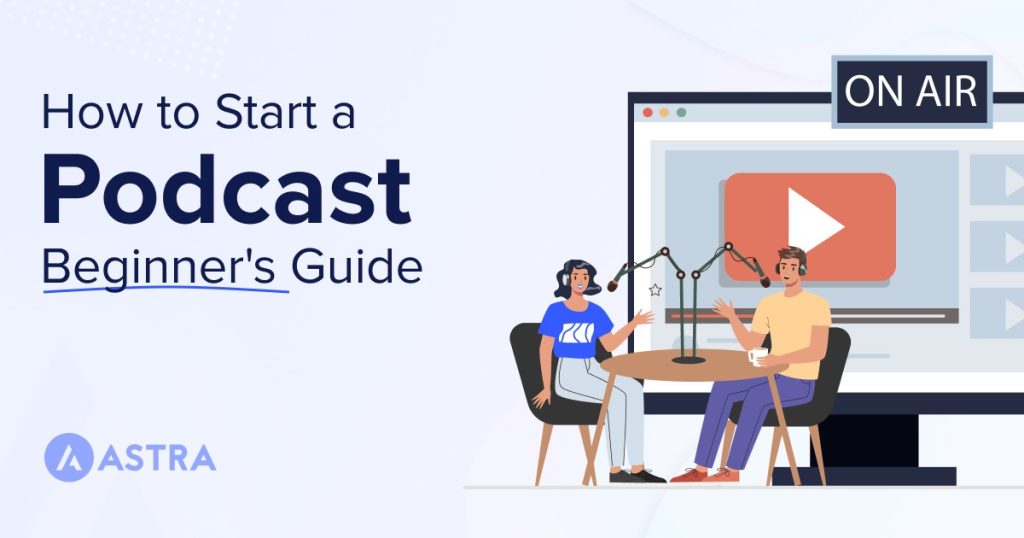If you’re thinking about starting a podcast, you’re not alone. In the past few years, podcasts have exploded in popularity, with Statista projections reporting an expected 424 million podcast listeners by the end of 2022.
But where do you start? How do you make sure your podcast is successful?
In this article, we’ll walk you through everything you need to know to start a podcast, from choosing a topic to launching your show.
- What is a podcast?
- How do podcasts work?
- Why start a podcast?
- How to start a podcast
- Where to host your podcast
- How to create a website for your podcast
- How to set up a WordPress website for your podcast
- How to distribute your podcast
- How to publish a podcast on your website
- How to make money with your podcast
- Frequently asked questions
- Conclusion: Will you start a podcast?
What is a podcast?
Podcasts are audio shows you can subscribe and listen to on your phone, tablet, or computer. They’re similar to radio shows, but you can listen to them whenever and wherever you want.
Most podcasts are free to listen to, and many are produced by independent creators. This means that there’s a podcast out there for everyone, on every topic imaginable.
How do podcasts work?
Podcasts are usually released in episodes, with each episode covering a specific topic. When you subscribe to a podcast, new episodes will automatically download to your device so you can listen to them whenever you want.
You can find podcasts using an app like Apple Podcasts or Stitcher, or by searching for the show name in your favorite search engine.

Why start a podcast?
There are lots of reasons to start a podcast.
Here are just a few:
- You can build an audience around your interests: If you’re passionate about something, there’s probably a podcast about it. But if there’s not, you can start your own! Podcasts are a great way to build an audience and connect with like-minded people.
- You can reach a global audience: Unlike radio shows which are limited to a certain geographic area, podcasts can be heard by anyone in the world with an internet connection. This means that you have the potential to reach a much wider audience than with other types of content.
- You can make money: While most podcasts are free to listen to, there are ways to make money from your show. You could sell advertising, create a Patreon, or sell products and services related to your podcast. If you’re looking to make some extra cash, starting a podcast could be a great way to do it.
- You can have fun: Podcasts are a great way to connect with other people and have fun while you’re doing it. If you enjoy talking and being creative, starting a podcast could be the perfect hobby for you.
Why should you make a website for your podcast?
A website is a great way to promote your podcast and build an audience.
Here are a few reasons why you should create a website for your show:
- You can control the branding of your show: When you have a website, you can choose how your podcast is presented to the world. You can design your own logo, write your own descriptions, and choose your own images. This allows you to create a strong brand for your show that will attract new listeners.
- You can reach a wider audience: A website makes it easy for people to find your podcast and subscribe to it. You can also use your website to promote your podcast on social media and other platforms.
- You can boost SEO value: A website can help you rank higher in search engine results, making it easier for people to find your show.
- You can increase viewer retention: A website allows you to post show notes and transcripts for each episode, which can help people follow along and understand your content better.
- You can make money: As we mentioned before, there are ways to make money from your podcast. Having a website makes it easy to sell advertising or promote products and services related to your show.
- You can build a community: A website is a great place to build a community around your podcast. You can create forums, write blog posts, and connect with your listeners. This can help you create a stronger connection with your audience and make your podcast more successful.
How to start a podcast
Now that you know what a podcast is and why you should start one, it’s time to get started!
Here’s a step-by-step guide to help you launch your own show:
Step 1. Choose a podcast topic
The first step to starting a podcast is to choose a topic. What are you passionate about? What do you want to talk about?
There are podcasts on every topic imaginable, so there’s sure to be one that’s perfect for you.
Step 2. Plan out your podcast
Once you’ve chosen a topic, it’s time to start planning out your podcast. First, you need to think about the type of podcast or format.
If you’re not sure, there are a few popular formats to choose from:
- Interviews: In this type of podcast, you’ll interview experts or interesting people on your chosen topic.
- Discussion: In this type of podcast, you and a co-host or guest will discuss various topics related to your chosen subject.
- Solo: In this type of podcast, you’ll be the only host and you’ll talk about your chosen topic for each episode.
Next, give some thought to what your initial episodes will be about? Who will be your guests, if you decide to have any?
Planning out your podcast ahead of time in this way will make it easier to produce and will help you stay on track.
It’s a good idea to prep the scripts for at least five episodes before you begin. This way, you’ll have a buffer and you won’t have to worry about what to say next.
Additionally, it’s helpful to record a podcast trailer (more on that below). This will give potential listeners a taste of what your show is all about and why they should tune in.
Lastly, take some time to figure out your schedule. How often will you release new episodes? What day and time will they be released?
Planning your schedule ahead of time will help you stay consistent and ensure that your listeners know when to expect new episodes.
Step 3. Choose a name and create artwork
Your podcast will need a catchy name and some eye-catching artwork. This will help you stand out in iTunes and other podcast directories.
Take some time to brainstorm a few potential names and create some artwork that represents your show.
Step 4. Purchasing and setting up podcasting equipment
Now it’s time to set up your recording equipment. If you don’t have any, don’t worry – it doesn’t have to be expensive.
All you need is a decent microphone and a quiet place to record.
To get started, first figure out where you’d like to record your podcast. If you have a home office or spare room, that’s ideal. If not, you can always record in a closet or even in your car (just make sure you’re not recording while you’re driving!).
Once you have a space chosen, set up your microphone.
If you’re on a budget, the Blue Yeti is a great option. It’s affordable and it produces great sound quality.

If you have a bit more to spend, the Rode NT-USB is also a great option. It’s a bit more expensive, but it comes with a built-in pop filter, which is helpful for reducing background noise.
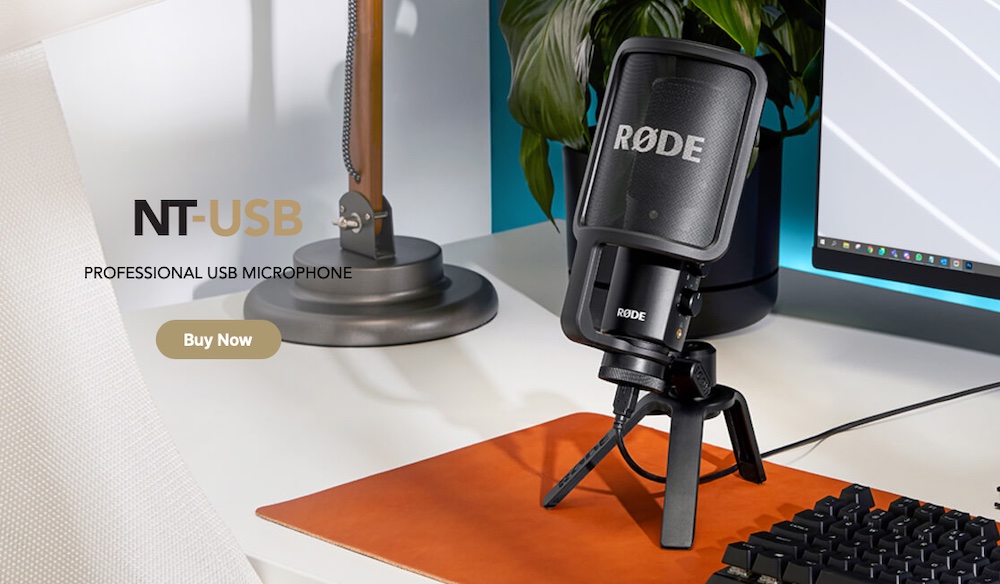
Step 5. Installing podcasting software
The next step is to install podcasting software on your computer. This will allow you to record and edit your podcast episodes.
There are a few different options to choose from, but Audacity is a great option for beginners. It’s free to download and it’s easy to use.
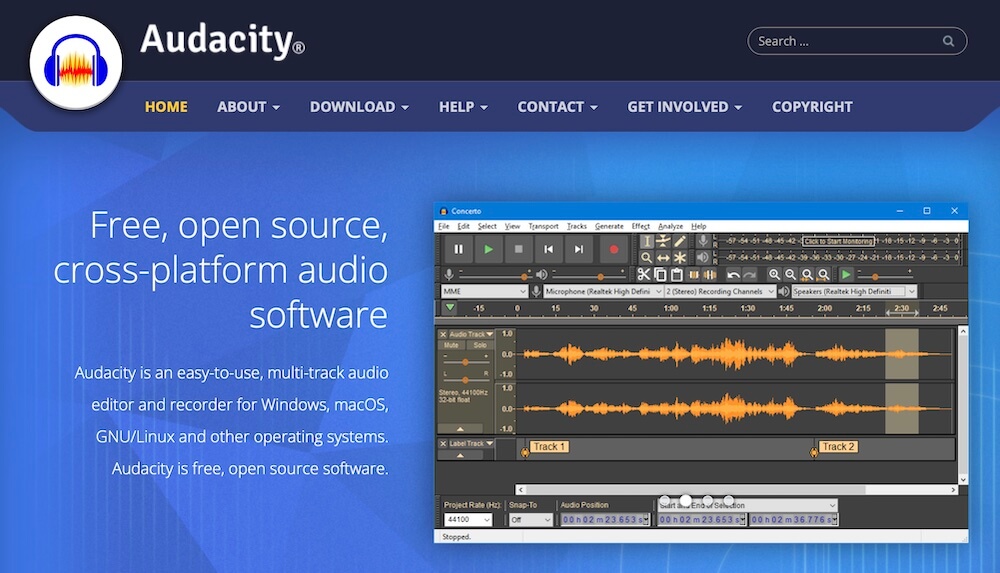
To get started, simply download the software as you would any other software then install as usual.
Step 6. Recording and editing your episodes
Now it’s time to start recording your podcast episodes!
Make sure you have your script handy, as well as any other materials you’ll need.
If you’re recording with a co-host or guest, introduce yourselves and have a brief chat before you start recording. This will help you to relax and get into the flow of things.
When you’re ready, hit record and start talking.

If you make a mistake, don’t worry – you can always edit it out later. Once you’re done recording, save your file and then you can start editing.
If you’re using Audacity, there are a few basic things you’ll want to do.
First, you’ll want to add an intro and outro to your episode. This can be some music or simply a short introduction and conclusion.
Next, you’ll want to edit out any mistakes or dead space. Lastly, you may want to add some sound effects or other audio enhancements.
Step 7. Exporting and uploading your podcast episodes
Once you’ve edited your podcast episode, it’s time to export it as an MP3 file. This is the format that most podcast players (like iTunes) use.
To do this in Audacity, go to File > Export > Export as MP3.
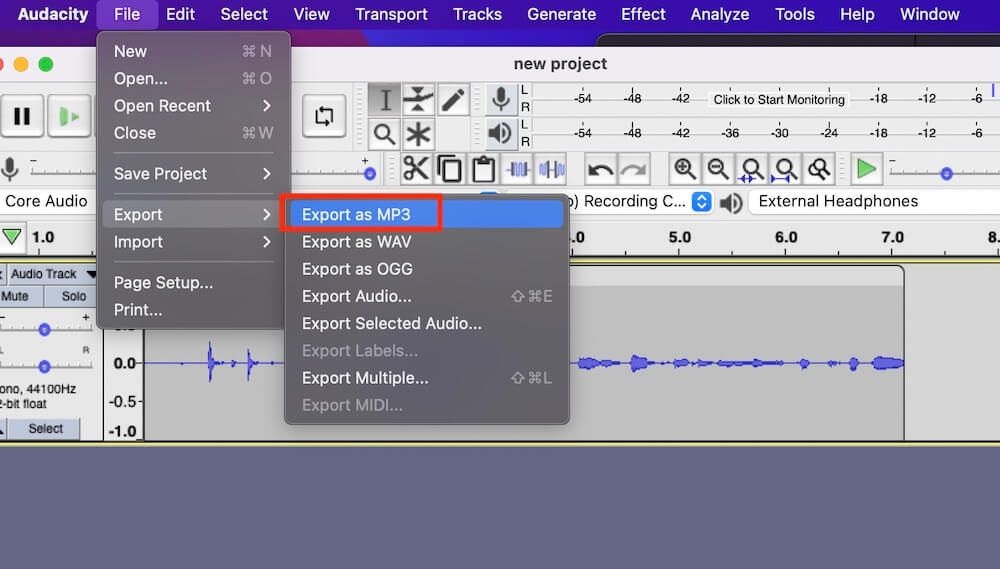
Once your file is exported, you’ll need to upload it to a hosting platform. This is where your podcast episodes will live and where people will be able to listen to them.
Where to host your podcast
There are a few different podcast hosting platforms to choose from. Some of the most popular options include Apple Podcast, Spotify, and YouTube.
In fact, Spotify is the most commonly used app for listening to podcasts in the United States.
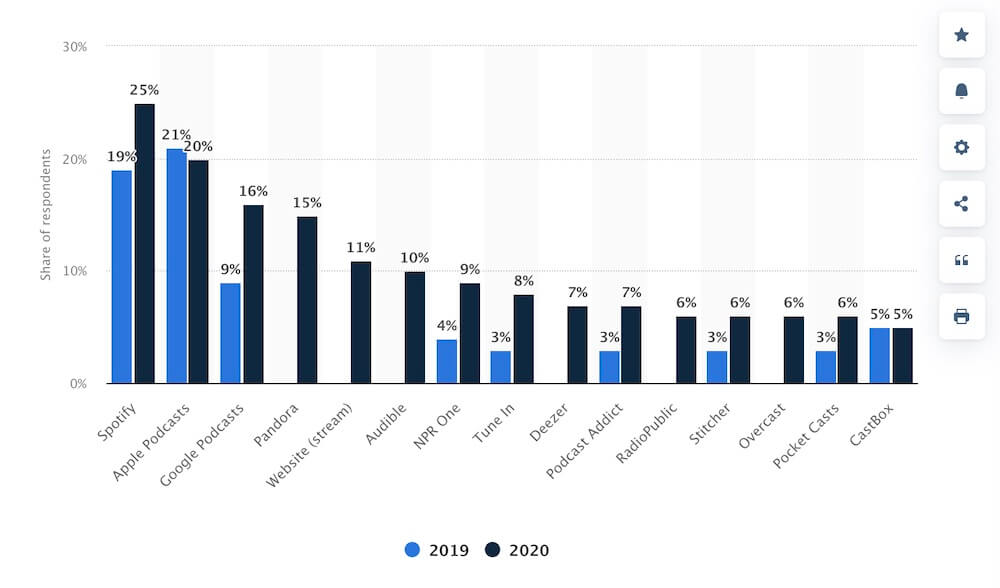
However, you can likely benefit from using just Anchor, which gives you access to the three platforms previously listed as well as many others including Google Play, Blubrry, Spreaker, and Castbox.

Anchor is a great option for hosting your podcast because it’s free and it’s easy to use. Plus, you can easily distribute your podcast to all of the major podcast platforms with just a few clicks.
To get started, sign up for an account and then create a new podcast. You’ll be prompted to enter some basic information about your podcast, such as the name, description, and artwork.
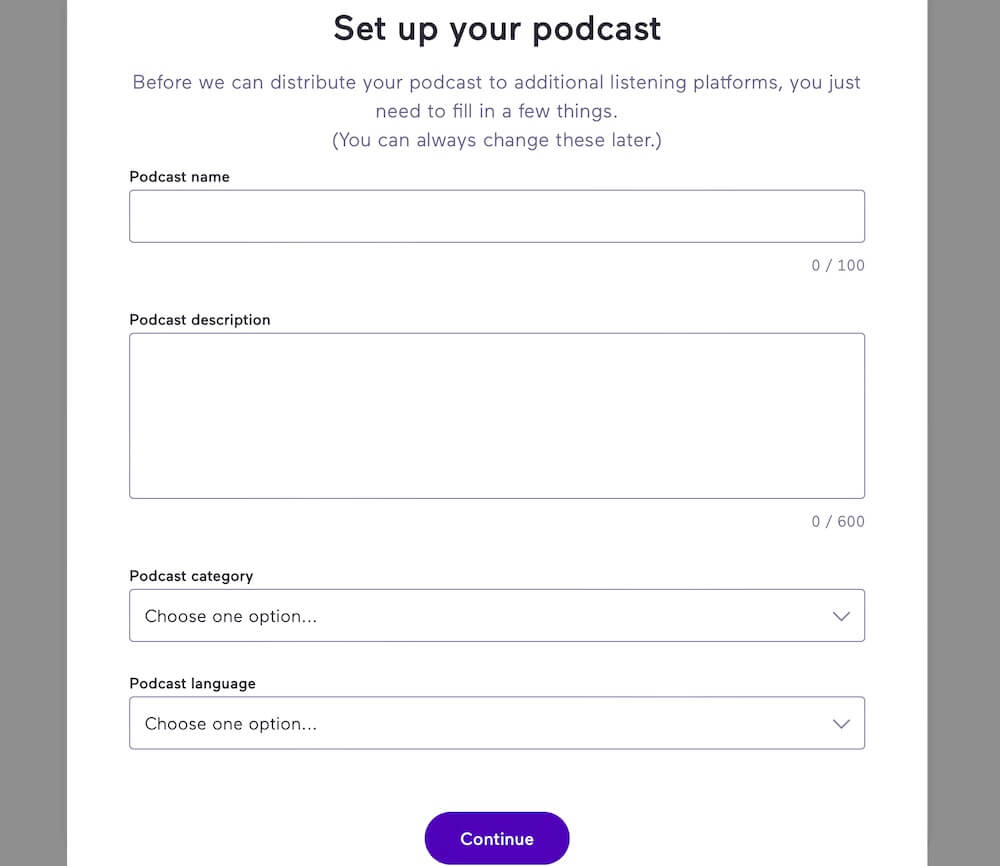
Once you’ve entered this information, you can upload your MP3 file and Anchor will take care of the rest.
How to create a website for your podcast
If you don’t already have a website for your podcast, now is the time to create one. A website is a great way to promote your podcast and to attract new listeners.
There are a few different ways you can create a website for your podcast. You can hire a web designer or use a platform like WordPress.
But before we get into the details of site setup, let’s first discuss why WordPress is the preferred way to build a podcast website.
Why use WordPress for your podcast website?
WordPress is a popular content management system (CMS) that powers millions of websites around the world. It’s known for being user-friendly and for its wide range of customization options.
This CMS is especially beneficial for podcasters because it makes it easy to post and organize your podcast episodes.
Plus, there are many WordPress themes and plugins specifically designed for podcasts. If you’re not a tech-savvy person, don’t worry – there are plenty of resources available to help you get started.
Now that we’ve discussed the benefits of using WordPress, let’s take a look at how to set up a WordPress website for your podcast.
How to set up a WordPress website for your podcast
To begin, you’ll need to secure web hosting and a domain name. Web hosting is where your website’s files will live and a domain name is your website’s address on the internet.
There are tons of web hosting providers to choose from including Siteground and Cloudways.
Many hosting companies offer a free domain name when you sign up for web hosting as well as 24/7 customer support in case you need any help along the way.
Once you’ve secured web hosting and a domain name, you can install WordPress.
To do this, log in to your web hosting account and click on the Install WordPress button.
Most hosts have a one-click install option for WordPress, so by all means, take advantage of that.
Choose a podcast theme
Once WordPress is installed, you can start customizing your website.
To do this, log in to the back-end of your site (yourdomain.com/wp-admin) and navigate to the Appearance section. Here, you can choose from a variety of podcast themes.
We recommend using the Creative Podcaster Starter Template that’s included with the Astra theme.
This template is specifically designed for podcasters and it comes with all the features you need to launch a successful podcast website. Or you can choose any other podcast website template.
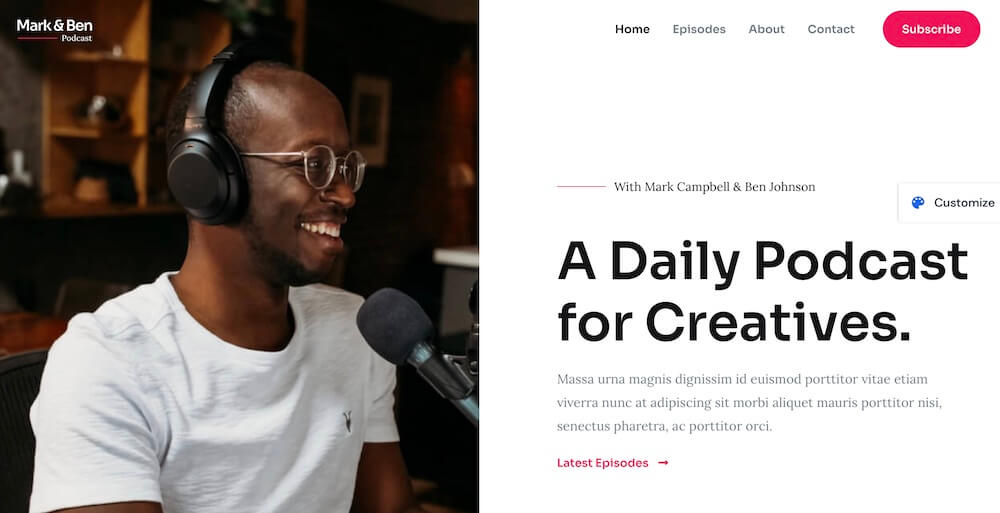
Some of these features include:
- A beautiful homepage layout that prominently displays your latest episodes
- The ability to easily embed audio files from popular podcasting platforms
- A built-in subscribe widget so listeners can easily subscribe to your show
To use this Starter Template, simply download the Astra theme, install it on your WordPress site, and then activate the Creative Podcaster template.
You can then make any other customizations you’d like at this time as well.
For example, you can upload your own logo, change the colors and fonts, add social media icons, and more.
Install podcasting plugins
Now that your WordPress site is set up and looking great, it’s time to install some plugins. These are essentially apps for your website that add extra functionality.
There are many great plugins available for podcasters, but we recommend starting with Presto Player.

Presto Player is a premium plugin that helps you showcase podcast episodes on your website in a beautiful way.
It also comes with some great features, such as the ability to display show notes, transcripts, and other related content.
There is a free version available but the robust feature set is only available through the premium version.
To use Presto Player, you’ll need to purchase the plugin directly from the website then download the file.
From there, log in to the back-end of your WordPress site and navigate to Plugins > Add New.
From here, click on Upload Plugin, locate the file on your computer and upload it. Once installed, you’ll need to activate the plugin by clicking Activate.
The only remaining setup step is to activate your plugin license.
To do this, go back to the Presto Player website, log in to your account, then click License Manage.

Under Key Generator click Generate License Key.
Copy the key that’s generated for you then go back to your WordPress dashboard and navigate to Presto Player > License.

Paste the key in the appropriate box and click Save. Presto Player will then be ready to use!
Now that the plugin is installed and configured, you can start adding your podcast episodes.
To do this, go to Presto Player in the WordPress dashboard then click Media Hub.
On the next page, click Add New at the top.
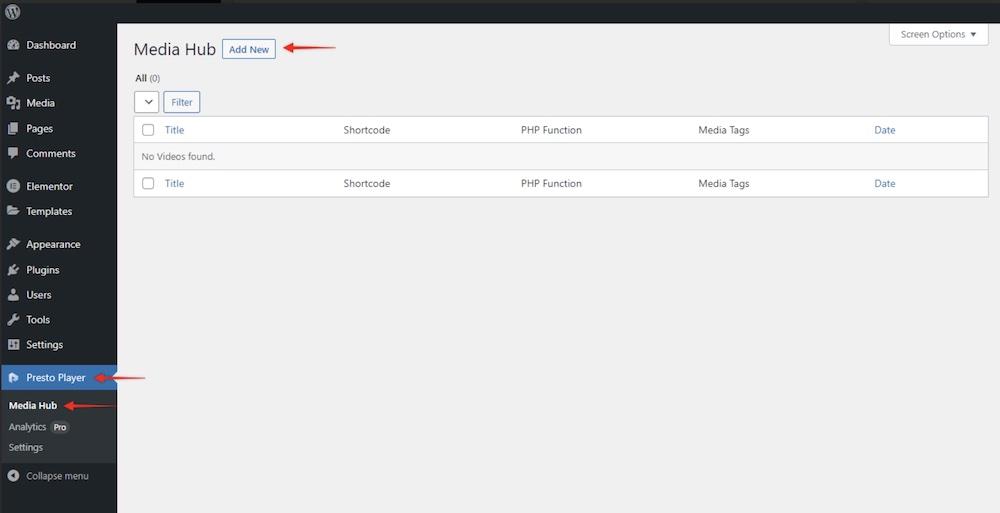
From there, you can select which video or audio type you’d like to upload or embed. You have five options, including: YouTube, Vimeo, Video (self-hosted), audio, and Bunny.net. The last option is only available to those who have Presto Player Pro.
If you wish to upload the podcast episode directly to your website, you can do so by clicking Add/Select Audio.

Otherwise, click Audio URL and input the URL to the episode you’ve uploaded elsewhere.
From here, you can enter the title of your episode, a description, and a caption.
Once you’re finished, click Select and the audio file will be inserted into a dedicated post. You can also make adjustments to how the audio player will appear:

You can then repeat this process for each of your episodes.
Other WordPress plugins to install
In addition to Presto Player, there are a few other WordPress plugins we recommend installing on your podcast website. They can round out your site’s feature set and to aid in both promotion and performance.
Here are a few other plugins to consider:
- Yoast SEO: This plugin is essential for helping you optimize your website and individual blog posts for the search engines.
- Smush: This plugin helps you optimize your images for faster loading times.
- Jetpack: This plugin is a must-have for any WordPress website. It includes features like social media integration, security, backup, and more.
- W3 Total Cache: This caching plugin speeds up your website by caching your pages and posts.
- OptinMonster: This powerful plugin allows you to grow your email list by adding opt-in forms to your website.
How to distribute your podcast
Once you have your podcast website set up, it’s time to start distributing your show on various platforms. This will help you reach a larger audience and get more listeners for your show.
If you’ve been following along here, then you’ve already set your account up on Anchor, so now’s the time to actively share your podcast episodes for real.
From the Anchor episodes page, click the pencil icon next to your podcast episode.
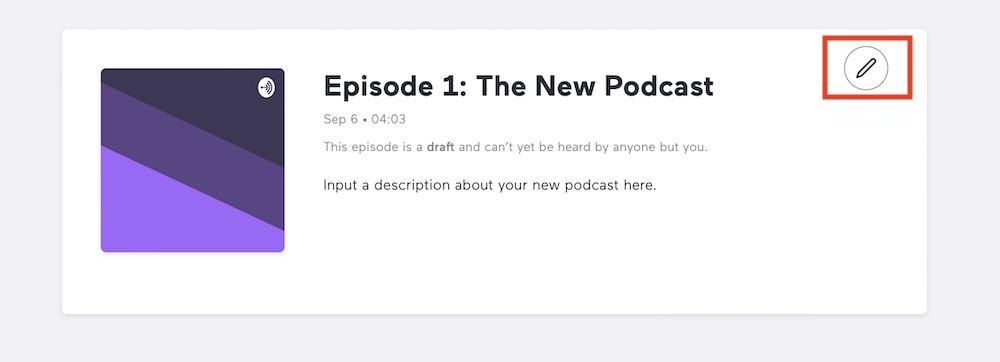
This will open your episode draft where you can modify the episode title, description, and publish date.
Click the Next button at the top of the page.

A dialogue will appear that prompts you to publish your podcast episode.
If you’re ready to make the episode live, click the Publish button. This will push your podcast live to Anchor and Spotify and then you can add more platforms later on.
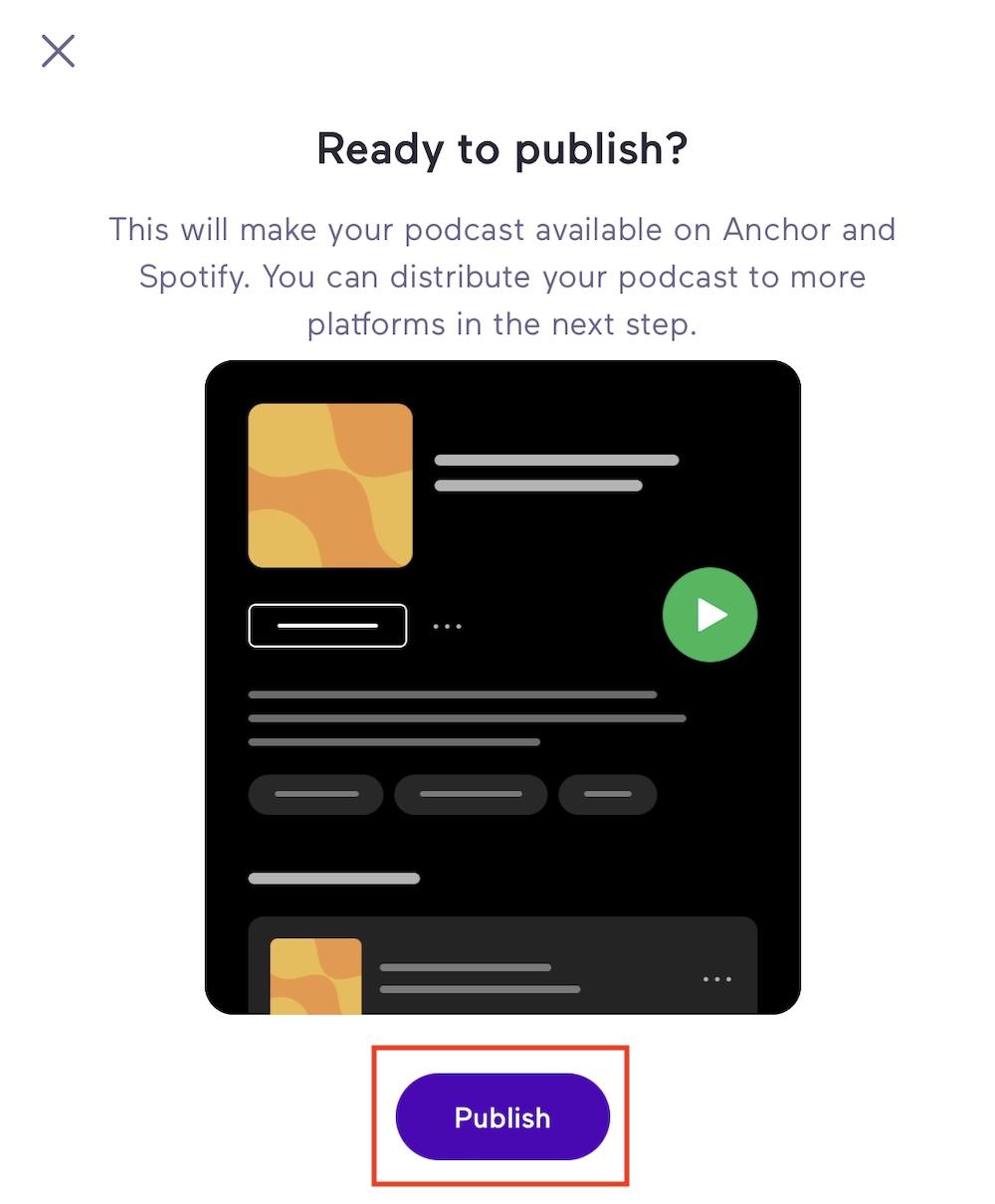
Your episode will now be distributed to all of the platforms that you selected.
It’s that easy!
In addition to sharing your episodes on Anchor, you can also submit your show to popular podcast directories, such as iTunes, Stitcher, and Google Play Music.
To do this, simply log in to the respective platform and follow their instructions for submitting a new podcast.
How to publish a podcast on your website
In addition to distributing your podcast on various platforms, you can also publish your episodes directly on your website.
In WordPress, you can do this by creating a new blog post for each episode.
To do this, go to your WordPress dashboard and click on the Posts section. From here, click on the Add New button.
You can then enter the title of your blog post and add content as normal.
You can also search the Blocks menu for Presto Player and click Presto Audio to insert an audio player directly into your post.
Here, you can select the audio file for your episode (as discussed previously), as well as enter a description and any other relevant information.
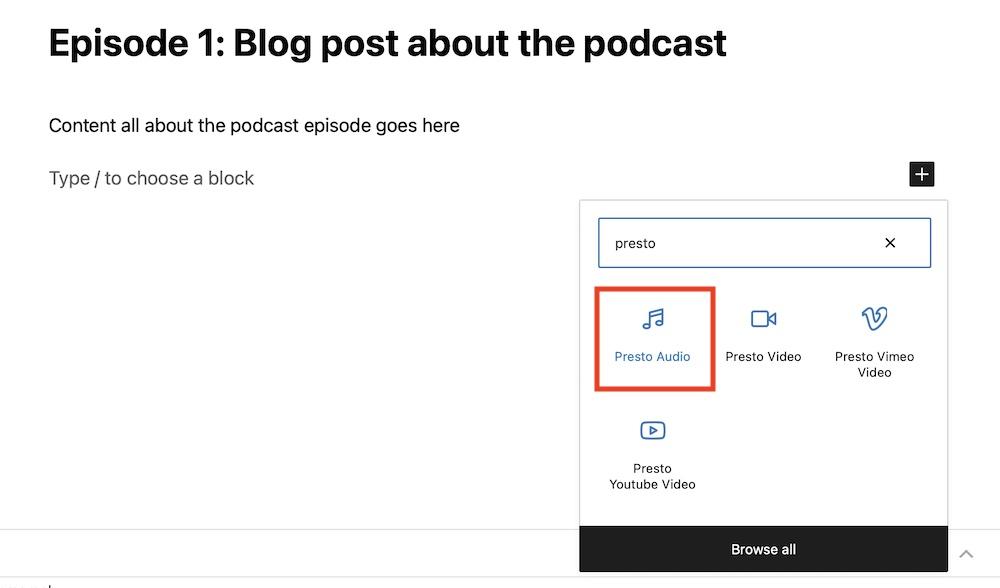
Once you’re finished, click on the Publish button to make the blog post featuring your new podcast episode live on your website.
How to make money with your podcast
Now you know how to start a podcast, it’s time to start thinking about ways to make money with your show.
The great thing about podcasts is that there are a number of different ways to monetize.
Here are a few of the most popular methods:
- Monetized podcast platforms: Platforms like Podbean allow you to charge listeners a monthly fee to access your content.
- Sponsorships: One of the most common ways to make money with a podcast is through sponsorships. You can find sponsors by reaching out to businesses that you think would be a good fit for your audience.
- Advertising: You can sell advertising spots on your podcast. To do this, you’ll need to find businesses that are willing to pay for ad space on your show.
- Product sales: If you have a product or service to sell, you can promote it on your podcast. This could be anything from an online course to a physical product.
- Merchandise: You can sell branded merchandise, such as t-shirts, mugs, and more.
- Affiliate marketing: You can make money with your podcast by promoting other people’s products and services. To do this, you’ll need to sign up for affiliate programs and then promote the products on your show.
- Patreon: Patreon is a popular platform that allows you to make money by getting people to sign up for monthly subscriptions. This is a great way to generate recurring revenue.
- Membership perks: Another way to make money is to offer exclusive content or perks to people who sign up for a monthly or annual membership. This could be anything from bonus episodes to exclusive access to a private Facebook group.
Recommended Articles:
– Best membership WordPress plugins
– How to create a membership site
– Membership site ideas for your business - Donations: Finally, you can accept donations from listeners who want to support your show. This is a great way to get started if you’re not sure how to monetize your podcast just yet.
- Consultation services: If you’re an expert in your field, you can offer consultation services. This could be anything from one-on-one coaching to group workshops.
- Public speaking and events: You can make money by speaking at events or hosting your own events. This is a great way to connect with your audience and generate some additional revenue.
No matter which method you choose, making money with your podcast is a great way to turn your passion into a profitable business.
Frequently asked questions
Still have questions about starting a podcast? Here are answers to some of the most frequently asked questions:
How much does it cost to start a podcast?
How often should I release new episodes?
How long should each episode be?
Do I need to be an expert on the topic?
How do I promote my podcast?
What are the best podcast hosting platforms?
Conclusion: Will you start a podcast?
Ready to get started? Use this guide to learn how to start a podcast and be on your way to success.
If you need any help along the way, don’t hesitate to reach out to a professional for assistance. With a little help, you’ll be up and running in no time.
And remember: you can’t go wrong with using the Creative Podcaster Starter Template for Astra to get your podcast website. up and running!
Do you have any tips on how to start a podcast? Share your advice in the comments below!
Disclosure: This blog may contain affiliate links. If you make a purchase through one of these links, we may receive a small commission. Read disclosure. Rest assured that we only recommend products that we have personally used and believe will add value to our readers. Thanks for your support!
